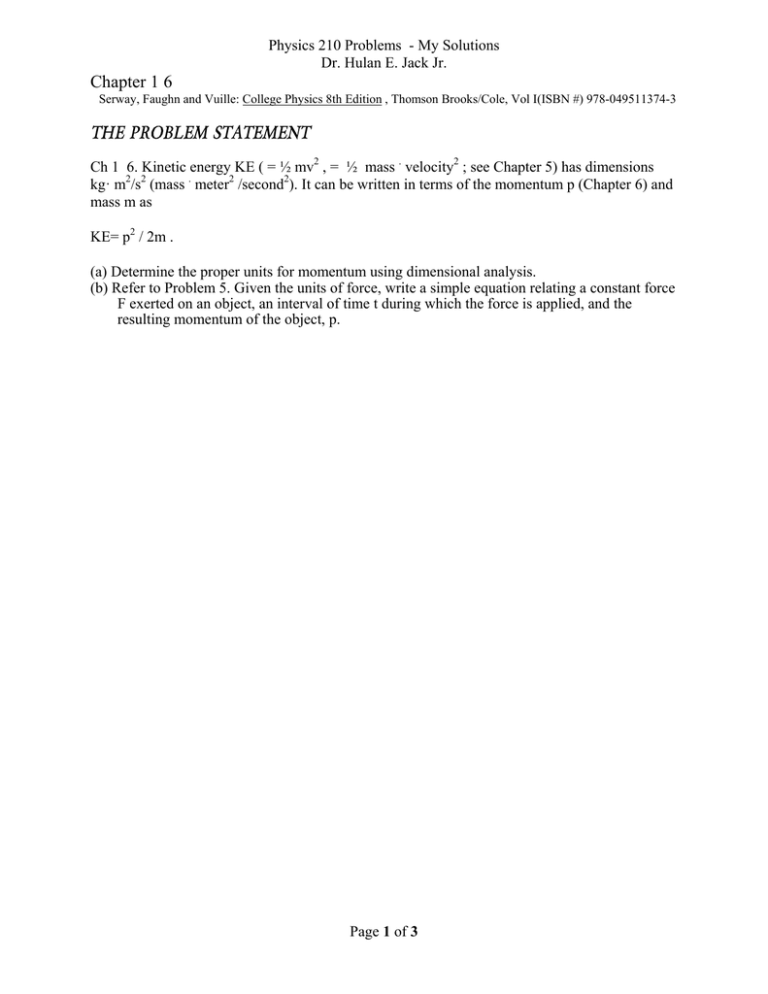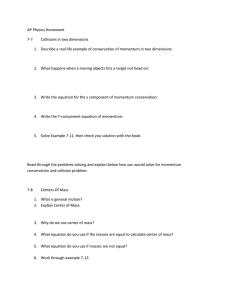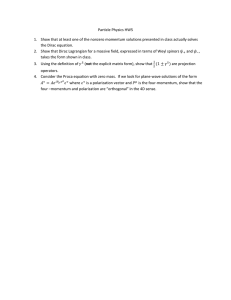Problems Chapter1 P6 My Solutions - PDF with thumbnails(pages) 2
advertisement

Chapter 1 6 Physics 210 Problems - My Solutions Dr. Hulan E. Jack Jr. Serway, Faughn and Vuille: College Physics 8th Edition , Thomson Brooks/Cole, Vol I(ISBN #) 978-049511374-3 THE PROBLEM STATEMENT Ch 1 6. Kinetic energy KE ( = ½ mv2 , = ½ mass . velocity2 ; see Chapter 5) has dimensions kg· m2/s2 (mass . meter2 /second2). It can be written in terms of the momentum p (Chapter 6) and mass m as KE= p2 / 2m . (a) Determine the proper units for momentum using dimensional analysis. (b) Refer to Problem 5. Given the units of force, write a simple equation relating a constant force F exerted on an object, an interval of time t during which the force is applied, and the resulting momentum of the object, p. Page 1 of 3 Physics 210 Problems - My Solutions Dr. Hulan E. Jack Jr. Ch 1 6. Kinetic energy KE ( = ½ mv2 , = ½ mass . velocity2 ; see Chapter 5) has dimensions kg· m2/s2 (mass . meter2 /second2). It can be written in terms of the momentum p (Chapter 6) and mass m as KE= p2 / 2m . (a) Determine the proper units for momentum using dimensional analysis. (b) Refer to Problem 5. Given the units of force, write a simple equation relating a constant force F exerted on an object, an interval of time t during which the force is applied, and the resulting momentum of the object, p. BRAINSTORMING - Definitions, concepts , principles and Discussion KE = ½ mv2 Units m t x v a F = ma , Physical Dimensions M s T m L m/s L/T L/T2 m/s2 kg*m/s2 ML/T2 KE kg m2/s2 kg ML2/T2 . p = mv p kg m/s ML/T ONLY DONE AS AN ILLUSTRATIVE EXAMPLE Let’s play with KE = kg m2/s2 = ML2/T2. Notice it is (M L/T)*(L/T) which is p*(L/T) because p is ML/T. But, if L/T is multiplied and divided by M , we get (M L/T)/M. This is p/M . So now KE = M/L2/T2 = (ML/T)*(ML/T)/ M = p*p/ kg = p2/kg = p2/m Hence KE has the units as p2/m Therefore KE = ½ p2/m . USE THIS METHOD FOR a. and b. Page 2 of 3 Physics 210 Problems - My Solutions Dr. Hulan E. Jack Jr. Ch 1 6. Kinetic energy KE ( = ½ mv2 , = ½ mass . velocity2 ; see Chapter 5) has dimensions kg· m2/s2 (mass . meter2 /second2). It can be written in terms of the momentum p (Chapter 6) and mass m as KE= p2 / 2m . (a) Determine the proper units for momentum using dimensional analysis. (b) Refer to Problem 5. Given the units of force, write a simple equation relating a constant force F exerted on an object, an interval of time t during which the force is applied, and the resulting momentum of the object, p. Basic Solution Units a. b. m t x v a F = ma , Physical Dimensions kg M s T m L m/s L/T 2 L/T2 m/s kg*m/s2 ML/T2 KE kg m2/s2 p = mv = mv = kg m/s = M L/T Units Dimensions Show that p = F t We know that p = (ML/T) and Since ML2/T2 F = (ML/T2). p = ML/T , we need a T2 on the bottom to get F. So multiplying and dividing p by T, gives pT/T = (ML/T) *T/T . Putting the T on the bottom (denominator) into the brackets, ( ) , yields p = (ML/(T*T))T = (ML/T2) T. But F = (ML/T2), so we have p = (ML/T2) T = FT . Page 3 of 3





